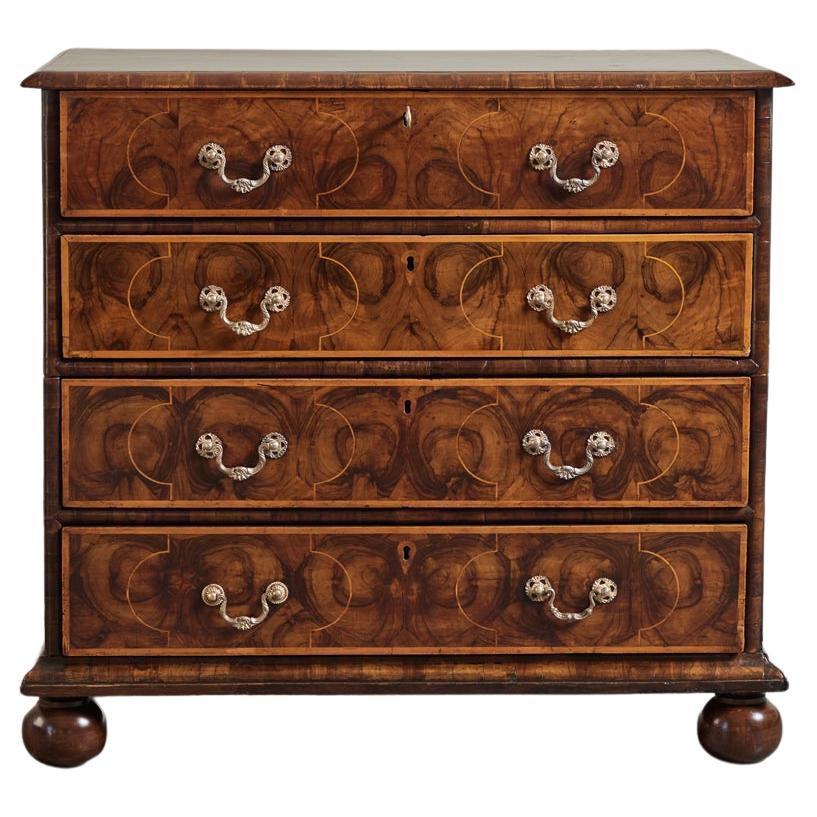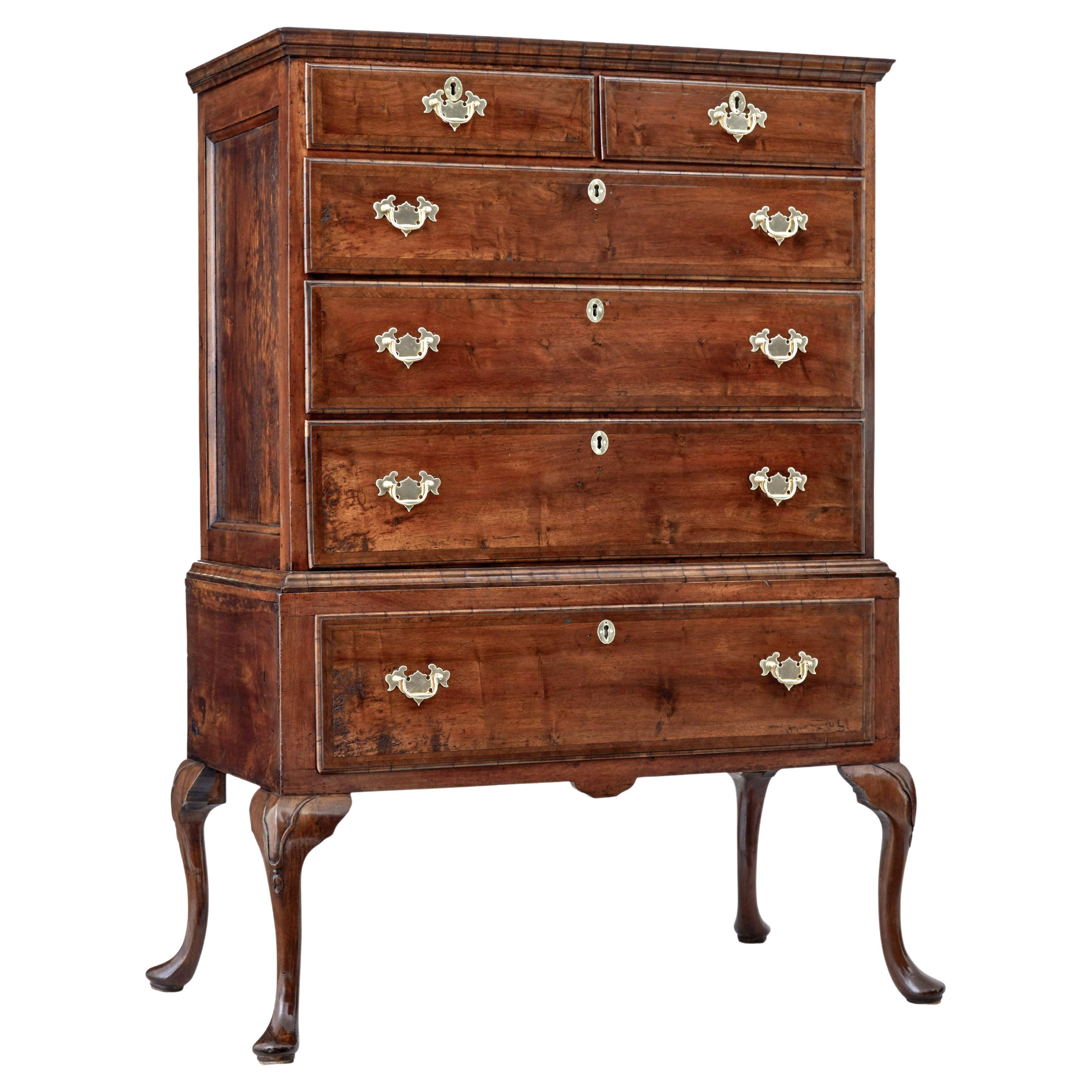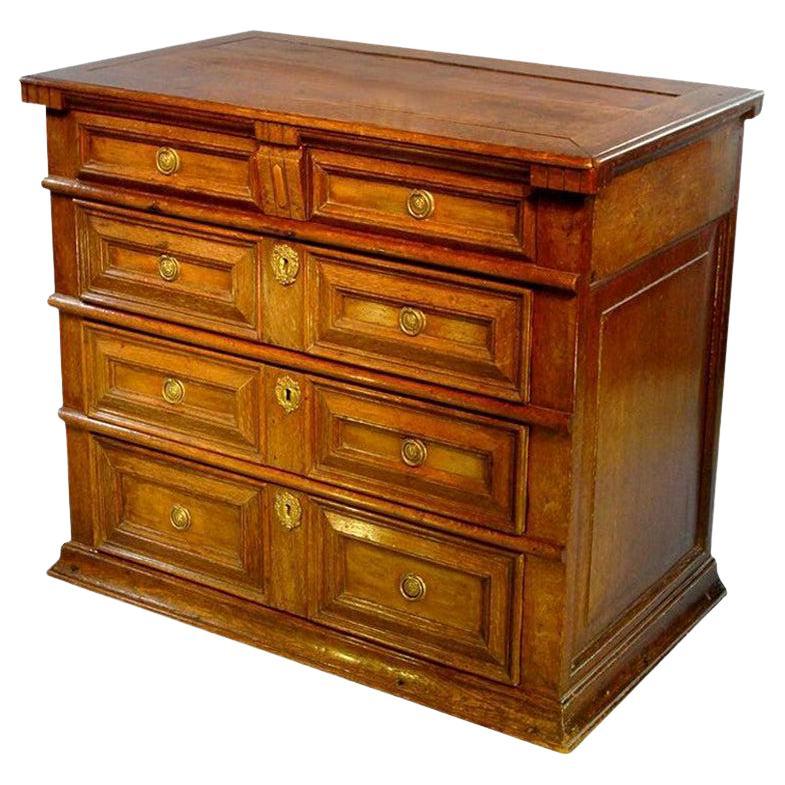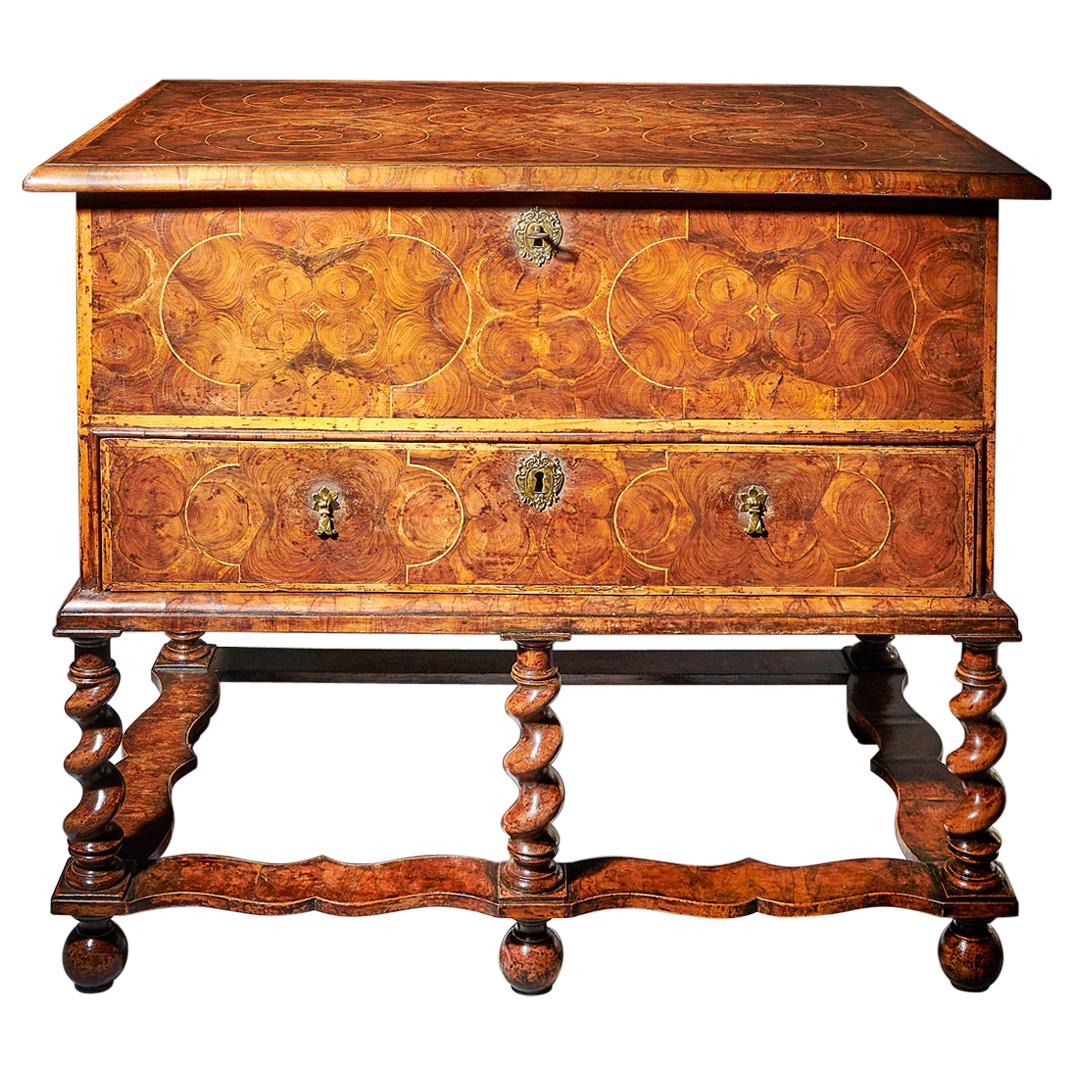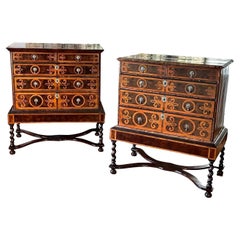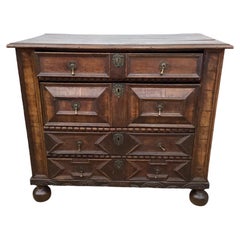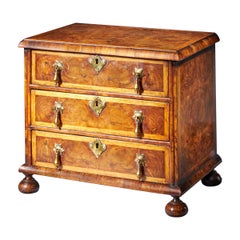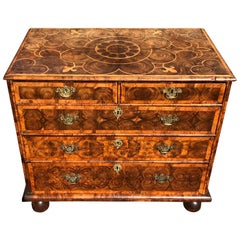
17th Century William & Mary Oyster Laburnum and Walnut Chest
View Similar Items
Want more images or videos?
Request additional images or videos from the seller
1 of 13
17th Century William & Mary Oyster Laburnum and Walnut Chest
About the Item
- Dimensions:Height: 33 in (83.82 cm)Width: 37 in (93.98 cm)Depth: 22 in (55.88 cm)
- Style:William and Mary (Of the Period)
- Materials and Techniques:
- Place of Origin:
- Period:
- Date of Manufacture:circa 1690
- Condition:Repaired: Minor historic repairs commensurate with age, mainly re-gluing of old veneers, with later bun feet and handles. Wear consistent with age and use.
- Seller Location:Lymington, GB
- Reference Number:Seller: BHA 10531stDibs: LU4081123840212
About the Seller
5.0
Vetted Seller
These experienced sellers undergo a comprehensive evaluation by our team of in-house experts.
Established in 1957
1stDibs seller since 2018
33 sales on 1stDibs
Typical response time: 15 hours
More From This SellerView All
- William & Mary Period Oyster Laburnum and Walnut ChestLocated in Lymington, GBAn English William & Mary period oyster laburnum and walnut chest ca 1700. William lll (1650-1702). A classic oyster-veneered chest of two short and three long graduated drawers all faced with exquisite oyster veneers banded in fruitwood. The top with well-chosen oyster inlays...Category
Antique Early 18th Century English William and Mary Commodes and Chests ...
MaterialsWalnut
- 17th Century English Oak And Walnut ChestLocated in Lymington, GBAn English oak and walnut chest of drawers. Charles II period (1630-1685). The drawer fronts with walnut inserts of super colour. The substantial moulded top has cleated ends. Conta...Category
Antique 1660s English Charles II Commodes and Chests of Drawers
MaterialsOak
- Fine Rare Pair 17th Century Oyster Walnut Chests on StandsLocated in Lymington, GBA fine, and rare, very closely-matched pair of late-17th century oyster walnut chests on stands. English, Charles II period, ca 1685. Both with f...Category
Antique 17th Century English Charles II Commodes and Chests of Drawers
MaterialsWalnut
- George III Mahogany Bachelor's ChestLocated in Lymington, GBA George III period mahogany bachelor's chest with caddy top, circa 1780. With four graduated cockbeaded drawers and a pull-out slide. Retaining its original brass swan-neck handles, locks and key escutcheons. This very useful Georgian bachelor (or bachelor's) chest was designed with a pull-out slide for ironing and folding clothes...Category
Antique Late 18th Century George III Commodes and Chests of Drawers
MaterialsMahogany
- 19th Century Inlaid Demilune Satinwood CommodeLocated in Lymington, GBAn English semi-elliptical, or demilune (half moon), inlaid satinwood commode of neoclassical form. Of very good rich color and patination. The marquetry in kingwood, tulipwood, burr veneers and harewood. The fine quality top inlaid with a large conch shell, with radiating trailing marquetry of bell-flower ribands, within a Vitruvian scroll border. This inlaid commode (or chest) contains three hinged cupboard doors each centred by oval panels inlaid with two-handled classical urns with drapery and flambeaux, on plinths set with burr veneers. The central cupboard revealing a bank of three oak-lined fitted drawers. The flanking cupboards with shelves. Raised on short square tapering legs and spade feet. 19th century, with 18th-century elements. All in excellent condition and of superb quality. Satinwood and marquetry commodes of this design reflect some of the highest achievements in English cabinet-making. Sometimes these antique commodes reveal the hand of two different master cabinet-makers, with tops differing from the bases. References: For a comparison see A. Hepplewhite and Co., Cabinet Maker, 'The Cabinet - Maker and Upholsterer's Guide' (1788) plate 78: ''Design for a Commode, enriched with painted or inlaid work adapted for a drawing room, within are shelves which answer the use of a closet or cupboard - may have one principal door in the front, or one at each end; are made of various shapes; and being used in principal rooms, require considerable elegance. The panels may be of satin wood, plain or inlaid; the top, and also the border round the front, should be inlaid.'' A fine George III satinwood and marquetry demilune commode attributed to Thomas Chippendale sold for £134,500 in Bonhams 'Fine English Furniture & Works of Art Sale', 19 Nov 2014. A related pair of satinwood commodes are in the Royal collection, made in 1781 for George IV when he was Prince of Wales. XQC 1988, 95, & XQC 2004, GIII, 284. See also Robert Adam, and Ince & Mayhew designs for similar satinwood marquetry commodes of the late 18th century. Vis. John Fowler...Category
Antique 19th Century English Commodes and Chests of Drawers
MaterialsSatinwood
- William and Mary Walnut Double Dome Bureau Bookcase or CabinetLocated in Lymington, GBA rare William & Mary period walnut double-dome bureau bookcase / cabinet. Circa 1685. Of compact size and proportions. In excellent overall condition with old, waxed, well-patinated surfaces of very good color. This bureau bookcase, or cabinet, divides into three separate sections (which helps date it to the last quarter of the 17th century). The bold double-dome pediment and cross-grain mouldings are typical of this period, and are repeated in the side returns. The book-matched, hand-cut veneers are well figured throughout, and are contained within herringbone lines. The bookcase section has candle slides, contains shelves and fitted drawers. Gilded finials are later. The centre section with a quarter-veneered fall reveals a fitted interior, concealed well and a secret compartment. The writing section is raised on a three-drawer base with an unusual and boldly-arcaded apron, in turn raised on its apparently original walnut bun feet. The drawer dividers are faced with cross-grain walnut ‘D’ mouldings. The brass engraved mounts are correct for period but not original, however the locks and hinges are. It is unusual to encounter these early bookcases / cabinets constructed in three stages; an indication of a transition taking place from the 17th into the 18th century. This is a fine, rare and sophisticated piece of late-17th century walnut furniture...Category
Antique 17th Century English William and Mary Cabinets
MaterialsWalnut
You May Also Like
- William and Mary Late 17th Century English Oyster Veneer ChestLocated in Pasadena, CAA William and Mary laburnum oyster veneered and line inlaid chest of drawers ca 1690. The top with well-chosen oyster inlays contained within contra...Category
Antique Late 17th Century English William and Mary Commodes and Chests o...
MaterialsOlive
- 17th Century William and Mary Oak ChestLocated in Chapel Hill, NCAn 18th Century William and Mary Oak Chest. Especially desirable size and proportion. This chest features the classic straight lines and sim...Category
Antique 17th Century English William and Mary Commodes and Chests of Dra...
MaterialsOak
- Miniature William and Mary 17th Century Diminutive Olive Oyster Chest, C.1690Located in Oxfordshire, United KingdomA Fine Miniature William and Mary 17th Century Diminutive Olive Oyster chest. From the reign of King William & Queen Mary (1688-1702), England. The...Category
Antique 17th Century English William and Mary Commodes and Chests of Dra...
MaterialsOlive
- Late 17th Century William and Mary Walnut Chest on StandLocated in Debenham, SuffolkLate 17th century William and Mary walnut chest on stand circa 1690. Good quality 2 piece William and Mary period chest on ori...Category
Antique Late 17th Century English William and Mary Commodes and Chests o...
MaterialsWalnut
- 17th Century William and Mary Olive Oyster Chest on Stand or Table BoxLocated in Oxfordshire, United KingdomA fine and extremely rare 17th century William and Mary baroque olive oyster chest on stand or 'table box', circa 1675-1690. The exquisite...Category
Antique Late 17th Century English William and Mary Commodes and Chests o...
MaterialsOlive
- Fine 17th Century William and Mary Figured Walnut Marquetry Chest of DrawersLocated in Oxfordshire, United KingdomA William and Mary walnut floral marquetry chest, circa 1690. The rectangular ogee moulded top with a central banded oval inlaid with spring ...Category
Antique 17th Century English William and Mary Commodes and Chests of Dra...
MaterialsBrass
Recently Viewed
View AllMore Ways To Browse
Oyster Walnut
William And Mary Commode
Oyster Chest Commode
William And Mary Walnut Cabinets
William And Mary Chest On Chest
English Antique Walnut Chest Of Drawers
Antique Walnut Chest On Stand
17th Century English Oak Chest
Cross Oyster
Dictionary Stand
William Kent Style
William And Mary Walnut Chest
Oyster Veneer Chest
Oyster Veneered Chest
Oyster Stand
English William And Mary Chest
William And Mary Walnut Chest Of Drawers
Oyster Veneer Chest Of Drawers

